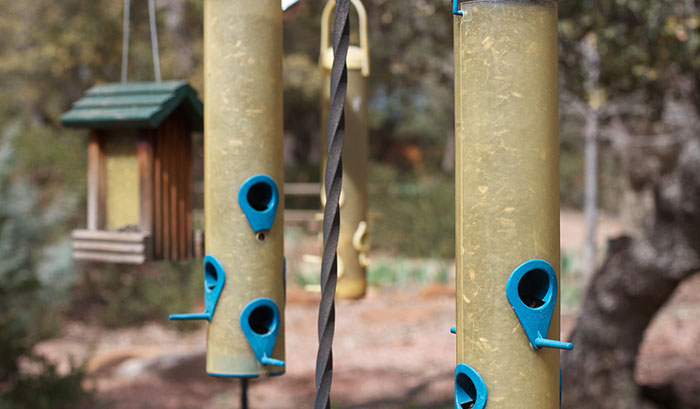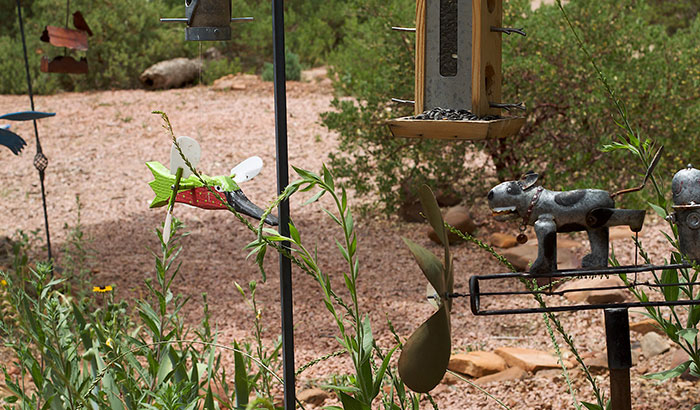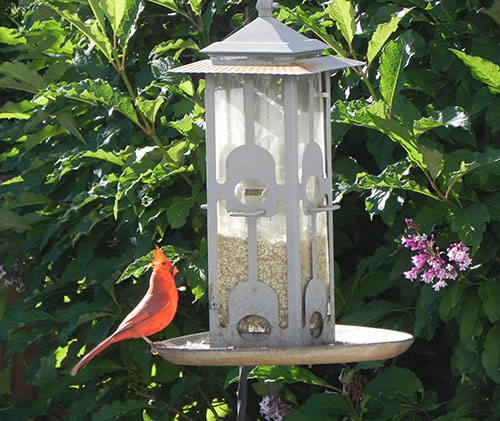Bird feeding is one great way to meditate and relieve stress since you’re giving back to our nature. However, it isn’t easy as putting the feeder wherever you prefer without considering various factors that benefit you and your feathered guests.
When deciding where to put bird feeders, some must-consider factors include bird safety and protection, accessibility, and positioning them in visible locations for observation.
Remember, ensuring the best location for bird feeders can help make diverse flying animals happy, protected, and properly nourished.
Skip through our valuable tips below to make your bird-feeding journey a blissful and successful experience.
Contents
Location Considerations
Safety
Above all else, birds’ safety should be your priority when deciding where to position the feeder. It’s fitting to place the feeder in an open and safe spot where you can safeguard birds from predators while they feed.
The bird feeder should be distant from squirrels, cats, and other roaming animals’ ambush sites. These sites include trees and fences where other predators can quickly jump and thick shrubs or woodlands where they can hide. Moreover, you must check if the feeder is protected from window collisions or other unfortunate incidents due to incorrect placement.
Accessibility for birds
The feeder is in the right location if you pick a clear area that allows an unhampered feeder view from a neighboring glass door or window. Alternatively, it’ll also be more accessible for you and diverse birds to hang the feeder in decks.
Restaurants operating in easy-to-access locations are a hit because they’re painless to locate, right? The same goes with bird feeders; if you place them in areas where birds can quickly navigate them, you hit the spot! Positioning feeders in an open and sunny location accessible and visible to feathered creatures flying overhead works marvels.
Protection from the elements
It’s saddening to know that more or less one billion birds perish annually due to window collisions. For this reason, it becomes more critical to ensure that you position your bird feeder away from the danger zone.
For instance, you must place the feeding station in covered locations if you live in regions with frequent typhoons and strong winds. This technique makes it plain sailing to clean and refill the bird feeders, regardless of inclement weather conditions in your area.
Feeders in shady spots shield the seeds and other bird food against direct sun heat, preventing them from spoiling instantly.
The Ideal Placement of Bird Feeders
Away from predators
Have you ever wondered why most birds act aloof and quickly fly away when you or other animals come closer? Anything they perceive as a threat scares them away, whether it’s a hungry raptor, squirrel, cat, hawk, and so on. Therefore, it is vital to ensure that the bird feeding station is distant from anything or anyone that can harm them.
Near cover and perching opportunities
Undeniably, all living creatures are always concerned about their safety, and birds are no exception. Birds feel secure, safe, and protected near shrubs, trees, woodlands, or anything that can offer them shelter.
It’s unsafe to place the feeders amid a barren garden, as no shelter will safeguard them from ravenous raptors. Your feathered guests will hesitate to land on your feeder if they’re exposed to predators, bird of prey, and other threats.
Evergreens can serve as excellent options acting as shelters for birds, as they help them fly quickly to escape from predators and other sorts of danger. They’re tried-and-true perching areas, as they continuously provide year-round protection.
In a visible location for observation
Giving yourself a relaxing and entertaining view every morning is one of the reasons why you install a bird feeder. Seeing vibrantly colored birds pecking, humming, and interacting with fellow birds feels like being so close to nature.
Hence, it’s paramount to place the feeder in a safe and accessible location that can give you a wondrous spectacle, especially when you’re feeling tired or bored.
Height and pole considerations
How high to hang a bird feeder?
The ideal height for feeding stations must consider the comfort and preference of birds when looking for food. Here are the most renowned bird feeder heights for typical backyard winged guests:
- 3 to 6 feet for hummingbirds that feed from vines and flowering bushes
- 6 to 10 feet for orioles that feed in trees and bushes
- 5 to 6 feet (eye level) for finches and cardinals that feed at lower levels
- 1 to 5 feet for towhees and sparrows, known as ground feeders
- 5 to 7 feet for bluebirds, known as ground or mid-level feeders
- 5 to 10 feet for titmice and chickadees, recognized as mid-level tree feeders
- 6 to 10 feet for woodpeckers that feed higher in trees
2. How tall should a bird feeder pole be?
Fortunately, there’s no restriction regarding the bird feeder pole’s height. You can make it as high as you prefer so long as it’s situated in a safe spot for your winged guests.
The truth is the pole’s height isn’t an issue for birds, but it can be uncomfortable or inconvenient to you if it’s too high. So, ensure the feeder is still reachable when cleaning and refilling it.
Most people find feeders 5 to 6 feet tall ideal and convenient, without requiring something to stand on when cleaning or refilling it.
Where to Put each Type of Bird Feeder?
Different types of bird feeders require ideal locations where to install them. For instance:
Tube feeders: Hanging the tube feeder to tree branches or a hook is crucial, as this feeder comprises a transparent and long cylinder. It also features perches and tiny openings along it, enabling smaller birds, such as chickadees, grosbeaks, sparrows, finches, and titmice, to feed quickly.
Bottle hummingbird feeders: It would help if you positioned this feeder where it’s safe from strong winds and sheltered from direct sunlight. This way, the bird food won’t spill out and spoil instantly.
Thistle seed feeders: Putting this feeder on or close to trees, woodlands, or shrubs is fitting, allowing birds like mourning doves, juncos, purple and gold finches, and quail to feel protected and locate it quickly.
Dish-style hummingbird feeders: You must hang more than one feeder, and the distance should be approximately ten feet apart to lure more hummingbirds.
Ground feeders: The best places to put ground feeders are underneath a tree cover and beneath the roof of a covered gazebo or patio. Starlings, pigeons, buntings, cardinals, and towhees prefer this feeder, as they love to forage for seeds on the ground.
Suet feeders: Bird species, such as wrens, nuthatches, jays, and woodpeckers, like suet feeders. The best location to install them is near dense tree branches or trunks.
Peanut feeders: Tufted titmice, nuthatches, woodpeckers, and blue jays love this feeder. Mount it with a hook, and install it high enough, distant from spots where other predators can reach the peanuts.
Hopper feeders: This feeder works well when you mount it on poles or hang it from tree branches. It looks like a small shelter for your winged guests to visit.
Wrap-up
Conclusively, knowing where to put bird feeders can spur an incredible difference in your bird-feeding journey. There’s a thin line between finding a spot for bird feeders near natural covering and safety but not too close that predators can quickly leap.
Remember, unveiling what different bird species prefer and need and the type of feeder you use can help you decide on the perfect location. Ensuring that you provide birds with sufficient food and placing the feeder away from the danger zone work miracles.
Do you have additional information to share about our “Where to Put Bird Feeders” post? Please leave your feedback below.





